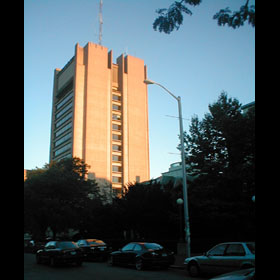
Intro
Built between 1969 and 1971, a few years after the Rockefeller Library was completed, the Sciences Library, although designed by the same team of architects, is quite a striking departure from the more traditional design of the Rock.
This 14-story, 180-foot reinforced concrete tower was projected to hold 450,000 volumes and its collections grew out of those of the Physical Sciences Library and the Biological Sciences Library. According to an article published in the Architectural Record in 1973, "Brown is one of the first universities in the nation to combine all its science departmental collections into a single library."
While the need for such an integrated sciences library was not debated, the particular of the concrete tower drew negative criticism on several accounts starting as early as 1962, when it was still on the drawing table.
Motivations
An integrated sciences library was felt to be needed in order to allow interdisciplinary research as well as minimize walking time between various libraries on campus.
Negative Reception
Before construction, the element open to attack was the most salient one at the time: the building's height. Concerned citizens of the neighborhood even succeeded in taking the matter to court, citing zoning laws that would have restricted the building's height to 40 feet. The concern seems to have been very steeped in practical matters such as the "devaluation of property in the vicinity."
Those in the community who were excited by the soaring height of the new building, among them "the crew" working on the site, mentioned the "spectacular" view. It should be noted that the site was structurally unsound. Lorraine L. Hopkins wrote in July 1970 that "it took six weeks to construct the 'sophisticated footings' necessary to compensate for the weakness in the ground." That might explain the existence of such a large basement. While sources do not directly link soil conditions to the building's layout, architectural critics have noted in several instances that "the architects put the largest-and busiest-space underground; the lower level covers five times the area of the tower."
While this underground area, with the sunken courts at the corners, is seen as a way to integrate the tower better on its natural site -- in other words, "to preserve the impact of a tower rising straight from the ground" -- it should be noted that a reasonably large circulation area would have been impossible to accommodate on one of the aboveground floors, given the nature of the design.
Function & Aesthetics
What the architects seem to have had in mind as a function for this building was mostly research. As critics have noted since the time of its completion, the building looks "like a giant bookstack." There was another aspect to the look as well, as the architects were aware of, provided for, and advertised the use of the computer in the building and in scientific research. It is this "scientific, computer look" advertised by Gertrude Gray, chief interior designer for the building, that Brown students animated in 2000 by turning one wall into a giant Tetris game.
Apart from this "scientific" look already mentioned, the building responds to its times in many other ways. The decision to build a tower might have several motivations. One of them would be the rather practical concern for land and the limits that such an expansion on the hilltop began to face at the time. At the same time, however, the tower shape was in fashion -- just like the New Brutalist aesthetic of rough concrete texture was an option when the architects envisioned the building.
On both the inside and outside of the Sciences Library, the exposed concrete and plastic furniture talk about a style that has more to do with advertising a function, that of a utilitarian repository space, than with the quality of human life in the building.
It's worth noting how the building is received today, when we look at an interior with late sixties chairs and the oil paintings on the rough cement surfaces. The building might just have turned "hip" in time, and there seems to be a commitment to preserve this aspect.
Sources
Waddington, Charles, "The Location of a Library's Science Collection," College and Research Libraries , Sep. 1965, 395-8.
"Up Is the Only Way Brown Can Go," Providence Journal , 6-4-66:A17.
"Two Libraries for Brown University," Architectural Record , Sep. 1966.
Citizens Action Associates paper, May 8, 2003, University Archives, The John Hay Library.
Hopkins, Lorraine L. "Brown library goes up and up," Providence Journal, 7-26-70:A7.
"Tower of Science at Brown Library," Interiors , Dec. 1972, 86-93.
"Present and Future Trends in Library Design and Planning," Architectural Record , 133 (Apr. 1973), 119-136.
"Ultimate Tetris: 'really cool'." Providence Journal , 4-20-00:A1.
Greenman, Catherine. "Ultimate Tetris, on a Very Big Screen," New York Times , 4-27-00:G6.
Hardi, Joel, "Tetris Anyone?" Chronicle of Higher Education, 46:36, 5-12-00.












